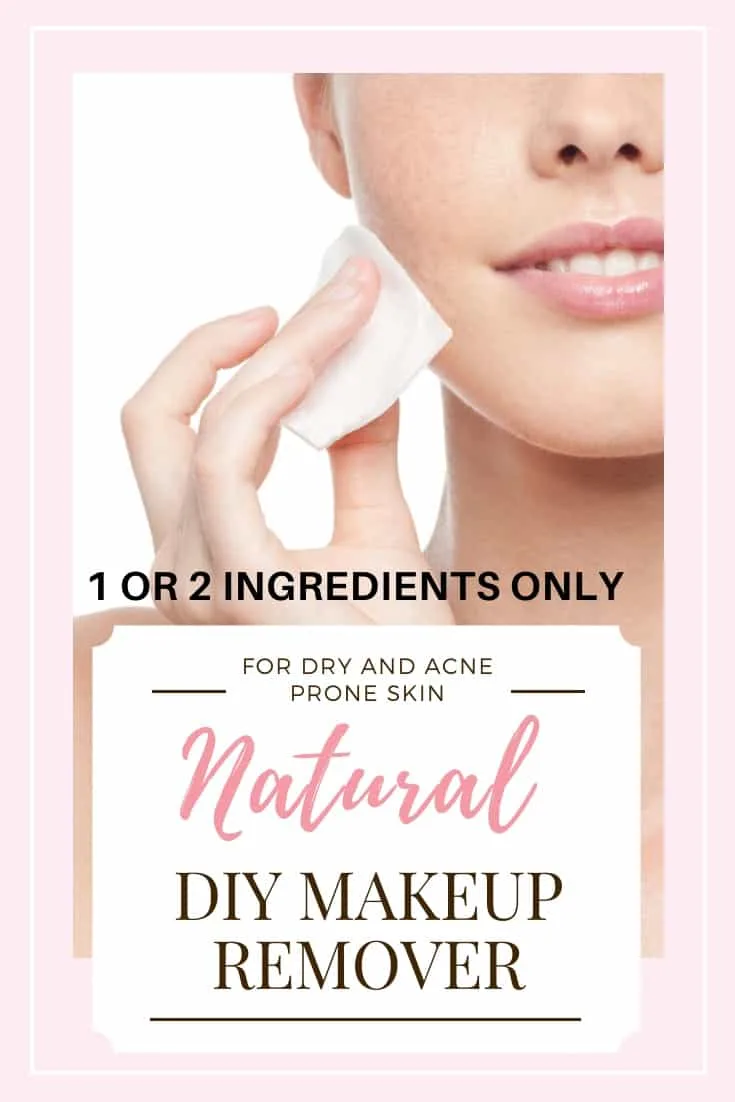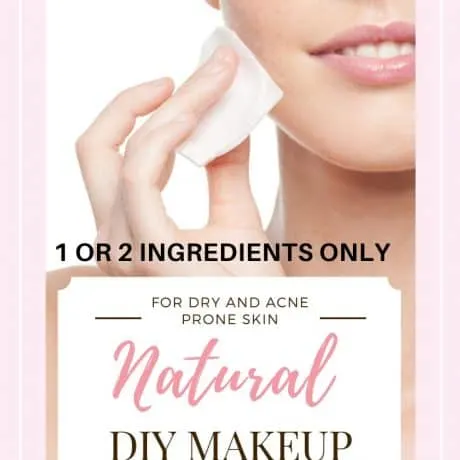A natural DIY makeup remover with minimum ingredients effective for any kind of makeup especially the “hard to clean one”. You will no longer need to buy chemical makeup remover ever or spend extra money on special products to remove your make up!

I used to use a drugstore makeup remover to clean up my makeup like everybody else, but when I finally paid attention to the label, there were already signs of concern. I committed to finding a more natural solution.
And so, I switched to a simple natural DIY makeup remover that has minimum ingredients and guess what, it works even better than the chemical loaded one! It cleanses even the most stubborn mascara, I was thrilled!
The Side Effects of Store-bought Makeup Remover
Most often if you read a random label you will see a long list of ingredients including surfactants, which dissolve makeup, emulsifiers, preservatives and other chemicals and fragrances. Over time if used on a regular basis all these chemicals find their way into the blood stream as they have the ability to easily penetrate the skin.
There are many studies already (chemicals in beauty products) that confirm the sad truth about the toxic and carcinogenic effects of these products.
Unfortunately conventional, store-bought makeup removing wipes pose the same problems: endocrine disruption ingredients, irritating chemicals that produce biochemical or cellular level changes to your body.
Why not replace all those hazardous products containing 50+ ingredients, with something that’s just as effective and even healthy.
DIY Makeup Remover Benefits
The best solution is one of the most simple, easy and inexpensive. For a natural DIY makeup remover you need just one ingredient: oil. Even in ancient times oil was used instead of soap for the whole body and then it was scraped off with a special tool.
Oil dissolves oil. By using plant oils, you can cleanse your pores of dirt and bacteria naturally, gently and effectively. They have a molecular structure that’s similar to our own natural skin oil (sebum), which means pure plant oils are readily accepted and absorbed by the skin.
A DIY Makeup Remover For Both Oily & Dry Skin
Not all oils are created equal, and while some might break us out (like coconut oil for example), the right ones can decrease skin oiliness and transform even the most blemish-prone skins. These incluse: rosehip oil, evening primrose oil, jojoba, and hemp seed oil. See the entire list of oils below.
If you have dry skin, or a skin condition such as mild eczema or psoriasis, using oil as a makeup remover is your best option. It will soothe your skin and give you relief from itchiness, flaking and cracking. The best oil are: argan, grapeseed, maracuja, flax-seed and olive oil. See the entire list of oils below.
Natural DIY Makeup Remover Recipe
My favorite DIY makeup remover recipe is pretty simple and consists of 1 or 2 ingredients (when I need more special care).
1. A carrier oil ( choose any of above mentioned by skin type – oily or dry).
2. An essential oil ( I use either German chamomile (Organic) Essential Oil or Frankincense Essential Oil (organic) – they are both highly anti-inflammatory, and soothing, they are even safe for kids!
Mix these two together and pour in a Bottle Pump Bottle (I love them because they prevent bacteria contamination) – and done!
A good rule of thumb is to use one drop of essential oil per teaspoon of carrier oil (1% dilution).

How To Apply Your DIY Makeup Remover
So first you want to remove the dirt. Use a cotton round pad, put a dime size amount of oil on and gently wipe. Simple as that! I find it helps to get the pad wet (squeeze the water out) before applying the oil – that way you don’t need as much oil.
If after you finish your skin is too oily, remove the excess with paper tissue or wash your face with warm water and tap dry, that’s what I usually do.
For the eyes, in order make sure I don’t have any oil left, I soak a cotton disc in warm water (squeeze the water out) and gently clean the eyelids and eyelashes.
Then if you want a deeper cleaning – take a facial steam bath or the steam from a cloth with hot water will open your pores, allowing the oil to be easily removed.
Then massage the skin with some more oil with circular motions for a few minutes, you will feel under your fingers dead skin cells coming off, then wash the excess oil with cold water and pat dry.
As a final step, once or twice a week I apply some honey for 10-15 minutes – naturally antibacterial honey (Manuka Honey or Raw Organic Honey) that fights acne and contains enzymes that help brush off dead skin cells.
The Best Oils To Remove Makeup
Argan Oil is pressed from the nut of the fruit of the Argan Tree, which is only found in Morocco. Because of the high levels of vitamin E /tocopherols (antioxidants) and saponins (skin-softening agents), argan oil is a wonderful oil for anti-aging. It can help reduce fine lines and wrinkles by restoring the skin`s hydro-lipid layer. It absorbs easily into skin and does not leave an oily residue. It is ideal for dry, damaged and wrinkled skin, improves skin elasticity and supports cell regeneration.
Hemp Seed Oil has anti-inflammatory qualities as its made up of 80% essential fatty acids (omega-6 / omega-3 almost equal amounts) helping to reduce the size of pores and to eliminate acne. It also protects the skin from free radicals and improves elasticity. It is often recommended in treating psoriasis and eczema.
The only way to know what your skin likes, is to experiment. See how your it reacts. Olive and coconut oil can be a bit heavy for some people and may cause clogged pores. Other people swear by them.
I usually start with an 60% ratio of jojoba and 40% of other oils specific for my skin type. You can adjust this ratio as needed. Several carrier oils can be combined to get the perfect combination.
Read More:
The Best DIY Face Moisturizer For Sensitive Skin
Skin Healing And Regenerating Whipped Body Butter Recipe




Jodi
Tuesday 25th of February 2020
Saved as a favorite, I love your website!
website
Sunday 14th of July 2019
Hello! Do you use Twitter? I'd like to follow you if that would be okay. I'm undoubtedly enjoying your blog and look forward to new updates.
HealthyTasteOfLife
Monday 15th of July 2019
Sorry I don't have an account on twitter.
West
Wednesday 2nd of May 2018
Woah! I'm really enjoying this info. It's simple, yet effective. Excellent Blog!
Elba
Tuesday 27th of March 2018
I’ve been exploring for a little bit for any high-quality articles or blog posts in this kind of niche. Thankfully I finally stumbled upon this website. Reading this info, i am glad I found out what I wanted. Many thanks for posting.
Shaunte
Friday 5th of January 2018
I love it when people come together and share opinions.
Great site, keep it up!